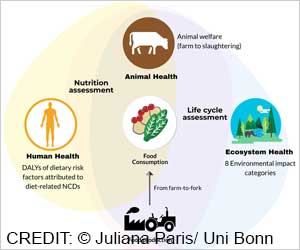When eating out, people tend to make more environment friendly choices if their foods are labeled as sustainable or not.
- Animal-based food production, especially red meat like beef accounts for 14.5% of global greenhouse gas emissions
- In a study with 5049 US adults, 23% more participants in the high–climate impact label condition ordered a sustainable (i.e., non–red meat) item //
- The study suggests that climate impact menu labels may be an effective strategy to promote more sustainable restaurant food choices and that labels highlighting high–climate impact items may be most effective
Impact on Sustainability Stamps on Food Ordering Choices
More than 5,000 adults 18 and older participated in the online survey. About two-thirds were white, 12% were Black and 17% were Hispanic. They were told to imagine that they were at a restaurant ordering dinner, after reviewing a fast-food menu containing 14 choices. Menu items included beef burgers, beef-substitute burgers, chicken and fish sandwiches, chicken nuggets, and various salads.When compared with those who chose from a regular, non-labeled menu, 23.5% more who ordered from a menu that flagged the least green choices ended up making a ‘sustainable’ meal choice. For example, they steered clear of red meat, a food whose production has a big climate impact. 10% more of participants made more sustainable choices when reviewing menus that indicated the greenest meals available.
Researchers found that both the high and low climate impact menu labels were effective at encouraging more sustainable food selections compared to the control. Although the most effective label was the one indicating high climate impact on beef items.
Sustainability or climate change menu labels are relatively new, and have not yet been implemented in fast-food restaurants. However, other kinds of labels, such as calorie labels, have been in restaurants for some time now. Other studies have shown that such labels do affect food ordering decisions (1✔ ✔Trusted Source
Effect of Climate Change Impact Menu Labels on Fast Food Ordering Choices Among US Adults
Go to source).
Researchers also found that when people made more sustainable choices, they also perceived them as healthier. That suggests climate-friendly fast-food labeling could be a win not just for the environment but also for waistlines.
Effect of Animal-Based Food Production on Environment
Animal-based food production, primarily driven by beef production, is responsible for 14.5% of global greenhouse gas emissions (GHGEs) and is an important modifiable contributor to climate change. In the United States, meat consumption, red meat consumption in particular, consistently exceeds recommended levels based on national dietary guidelines. Shifting current dietary patterns toward more sustainable diets with lower amounts of red meat consumed could reduce diet-related GHGEs by up to 55%. More environmentally sustainable diets containing less red meat could also have health benefits; evidence links consumption of red meat with increased risk of mortality, stroke, colon cancer, and type 2 diabetes.Fast food restaurants are an important source of red meat in the U.S. diet; on a typical day, more than one-third of U.S. individuals consume fast food, which is associated with numerous adverse health outcomes. Therefore, fast food restaurants are an important setting to encourage more environmentally sustainable dietary choices. One strategy to encourage such choices is the use of sustainability labels on restaurant menus indicating the climate impact of each menu item based on its associated GHGEs, or carbon footprint.
A better approach would be to focus on the food system rather than just one specific food item on a menu when it comes to sustainability and climate friendliness.
Reference:
- Effect of Climate Change Impact Menu Labels on Fast Food Ordering Choices Among US Adults - (https://jamanetwork.com/journals/jamanetworkopen/fullarticle/2799947)
Source-Medindia
















